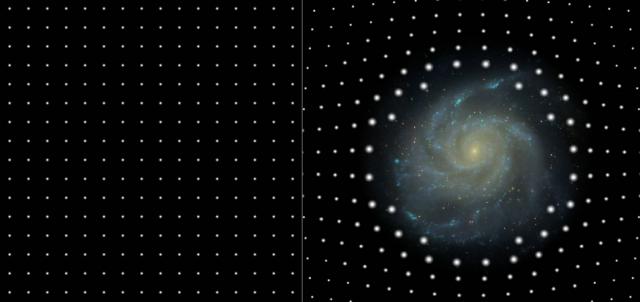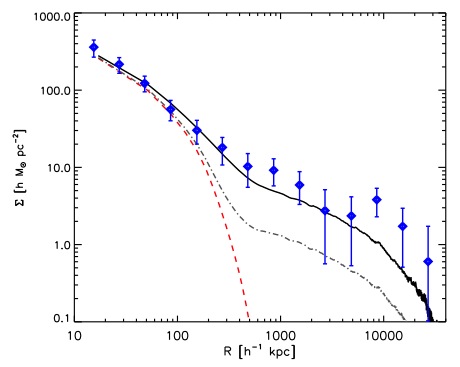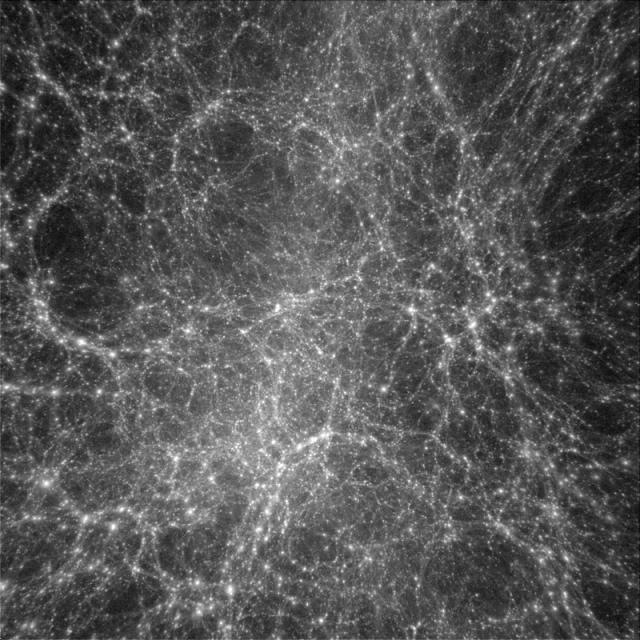Researchers at IPMU and Nagoya University used large-scale computer simulations and recent observational data of gravitational lensing to reveal how dark matter is distributed around galaxies.
Galaxies have no definite "edges", the new research concludes. Instead galaxies have long outskirts of dark matter that extend to their nearby galaxies; the inter-galactic space is not empty but filled with dark matter.
The research article has been published in the February 10th issue of The Astrophysical Journal.
Publication: The Astrophysical Journal 746, 38 ( 2012 February 10 )
Title: Matter Distribution around Galaxies
Authors:
Shogo Masaki (Department of Physics Nagoya University, JSPS Fellow)
Masataka Fukugita (Institute for Cosmic Ray Research University of Tokyo, IPMU)
Naoki Yoshida (IPMU)
Journal is here, Preprint is here.
Scientific Contact:
Shogo Masaki, Nagoya University
E-mail: shogo.masaki _at_ nagoya-u.jp
Media Contact
IPMU PR office Tomomi Hijikata / Yoshihisa Obayashi
E-mail: press _at_ ipmu.jp
Phone: +81 4-7136-5977
Summary
It is well known that there is a large amount of unseen matter called "dark matter" in the universe. It constitutes about 22 percent of the present-day universe while ordinary matter constitutes only 4.5 percent. An important question still remains - Where is most of the dark matter in the universe ?
Einstein's theory of general relativity predicts that a light ray passing through near a massive object such as a galaxy is bent by the effect called "gravitational lensing". For example, the effect causes the image of a distant galaxy to be deformed and brightened by an intervening galaxy. However the effect itself is very small and so cannot be easily detected for a single galaxy. Only recently, images of millions of galaxies from Sloan Digital Sky Survey (SDSS) made it possible to derive an averaged mass distribution around the galaxies. Earlier in 2010, an international research group led by Brice Menard then at University Toronto and Masataka Fukugita at IPMU used twenty four millions galaxy images from SDSS and successfully detected gravitational lensing effect caused by dark matter around the galaxies. From the result, they determined the projected matter density distribution over a distance of a hundred million light years from the center of the galaxies.
Masataka Fukugita and Naoki Yoshida at IPMU, together with Shogo Masaki at Nagoya University, used very large computer simulations of cosmic structure formation to unfold various contributions to the projected matter distribution. They showed that galaxies have extended outskirts of dark matter, well beyond the region where stars exist. The dark matter distribution is well organized but extended to intergalactic space, whereas luminous components such as stars are bounded within a finite region. More interestingly, the estimated total amount of dark matter in the outskirts of the galaxies explains the gap between the global cosmic mass density and that derived from galaxy number counting weighted by their masses. A long standing mystery on where the missing dark matter is now solved by the research. There is no empty space in the universe. The inter-galactic space is filled with dark matter.
 Figure 1: The two images illustrate the effect of gravitational lensing. A massive galaxy at the center of the right panel causes the images of the background galaxies (white spots) to be enlarged and brightened.(Image credit: Joerg Colberg, Ryan Scranton, Robert Lupton, SDSS, http://www.sdss.org/news/releases/20050426.magnification.html)
Figure 1: The two images illustrate the effect of gravitational lensing. A massive galaxy at the center of the right panel causes the images of the background galaxies (white spots) to be enlarged and brightened.(Image credit: Joerg Colberg, Ryan Scranton, Robert Lupton, SDSS, http://www.sdss.org/news/releases/20050426.magnification.html)
 Figure 2: The surface mass density as a function of distance (in units of a hundred thousand light-years). The blue points are observational data, whereas the solid line is the result of a computer simulation. The contributions from the central galaxy (red line) and from nearby galaxies (dashed line) are also shown.
Figure 2: The surface mass density as a function of distance (in units of a hundred thousand light-years). The blue points are observational data, whereas the solid line is the result of a computer simulation. The contributions from the central galaxy (red line) and from nearby galaxies (dashed line) are also shown.
 Figure 3: A computer simulation shows dark matter is distributed in a clumpy but organized manner. In the figure, high density regions appear bright whereas dark regions are nearly, but not completely, empty.
Figure 3: A computer simulation shows dark matter is distributed in a clumpy but organized manner. In the figure, high density regions appear bright whereas dark regions are nearly, but not completely, empty.






